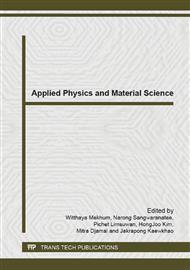[1]
Ahmed, S N, Physics & Engineering of Radiation Detection. 1st ed. England: Academic Press Inc.; (2007).
Google Scholar
[2]
Ahmadi, M., Lunscher, N. and Yeow, J. T.W., 2013. Effective atomic numbers and electron densities of bacteriorhodopsin and its comprising amino acids in the energy range 1 keV–100 GeV. Nucl. Instr. And Meth. In Phys. Res. B 300: 30-34.
DOI: 10.1016/j.nimb.2013.01.002
Google Scholar
[3]
Bhandal, G.S. and Singh, K., 1993. Photon Attenuation Coefficient and Effective Atomic Number Study of Cements. Appl. Radiat. Isot. 44: 1231-1243.
DOI: 10.1016/0969-8043(93)90070-q
Google Scholar
[4]
Gowda, S., Krishnaveni, S. and Dowda, R., 2005. Studies on effective atomic numbers and electron densities in amino acids and sugars in the energy range 30–1333 keV. Nucl. Instrum. Methods Phys. Res., Sect. B 239: 361-369.
DOI: 10.1016/j.nimb.2005.05.048
Google Scholar
[5]
Kurudirek, M., Buyukyildiz, M. and Ozdemir, Y., 2010. Effective atomic number study of various alloys for total photon interaction in the energy region of 1 keV–100 GeV. . Nucl. Instrum. Methods Phys. Res., Sect. A 613: 251-256.
DOI: 10.1016/j.nima.2009.11.061
Google Scholar
[6]
Manohara, S.R. and Hanagodimath, S.M., 2007. Studies on effective atomic numbers and electron densities of essential amino acids in the energy range 1 keV–100 GeV. Nucl. Instrum. Methods Phys. Res., Sect. B 258: 321-328.
DOI: 10.1016/j.nimb.2007.02.101
Google Scholar
[7]
Manohara, S.R. and Hanagodimath, S.M., 2007. Effective atomic numbers for photon energy absorption of essential amino acids in the energy range 1 keV to 20 MeV. Nucl. Instr. And Meth. In Phys. Res. B 264: 9-14.
DOI: 10.1118/1.2815936
Google Scholar
[8]
Manohara, S.R. , Hanagodimath, S.M., Thind, K.S. and Gerward, L., 2008. On the effective atomic number and electron density: A comprehensive set of formulas for all types of materials.
DOI: 10.1016/j.nimb.2008.06.034
Google Scholar
[9]
Moreira, A.C. and Appoloni, C.R., 2006. Mass attenuation coefficient of the Earth, Moon and Mars samples over 1 keV–100 GeV energy range. Appl. Radiat. Isot. 64: 1065-1073.
DOI: 10.1016/j.apradiso.2006.04.002
Google Scholar
[10]
Kumar, T.K. and Reedy, K.V., 1997. Effective atomic numbers for materials of dosimetric interest. Radiat. Phys., Chem. 50: 545-553.
Google Scholar
[11]
Gerward, L., Guilbert, N., Jensen, S.N. and Levring, H., 2004. WinXCom - a program for calculating X-ray attenuation coefficients. Radiat. Phys., Chem. 71: 653-654.
DOI: 10.1016/j.radphyschem.2004.04.040
Google Scholar


